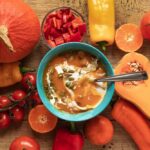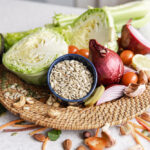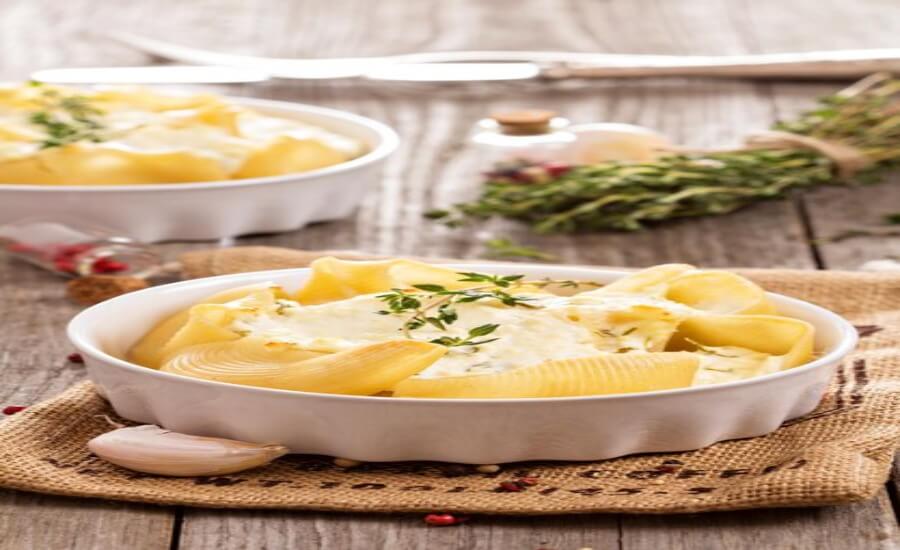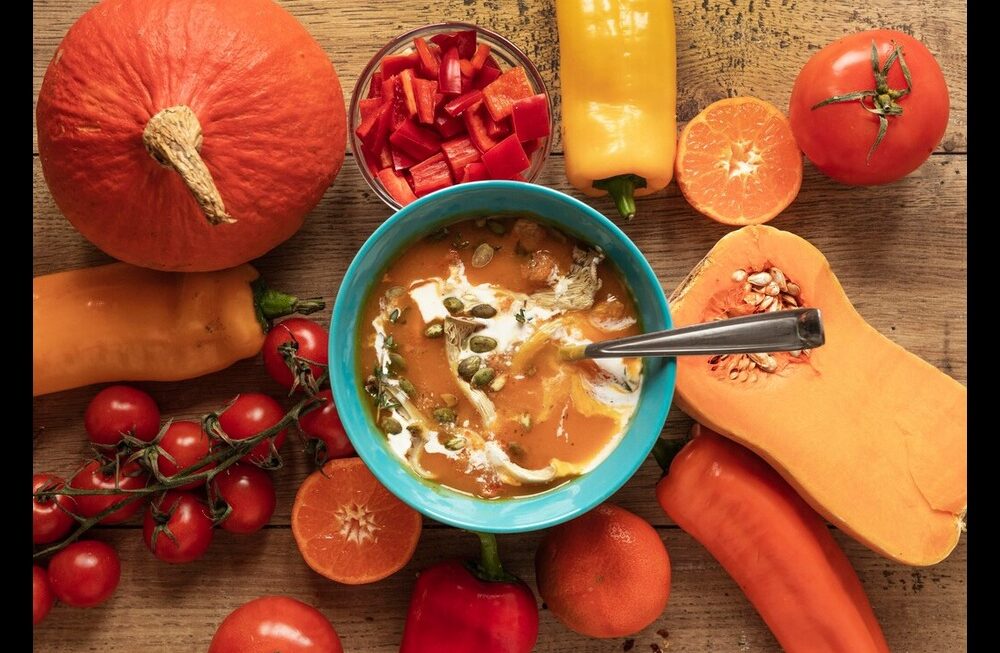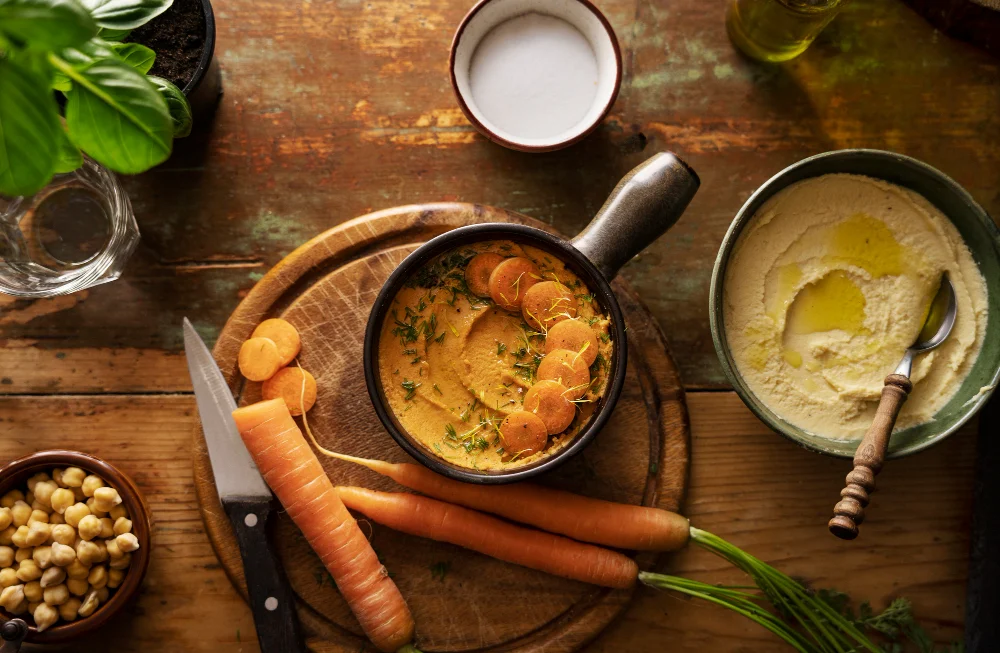Macaroni and cheese – it’s the ultimate comfort food for many, evoking feelings of warmth, nostalgia, and cheesy bliss. But can this dairy-laden classic truly be replicated in a vegan kitchen without sacrificing that signature creaminess and savory flavour? The answer is a resounding yes! Making incredibly delicious, creamy vegan mac and cheese at home is not only possible but also opens up a world of flavour and allows for mindful ingredient choices. This guide dives into the secrets of plant-based mac and cheese mastery, exploring various sauce bases, nutritional considerations, ethical aspects, environmental impacts, and providing practical recipes and techniques adaptable for home cooks everywhere, including right here in Jaipur.
LENS 1: Nutritional Analysis (Comfort with Consciousness)

While undeniably comfort food, homemade vegan mac and cheese can be crafted with nutritional advantages over traditional versions and processed boxed mixes.
- The Creamy Base – A Nutritional Spectrum: Achieving creaminess without dairy cheese/milk involves different plant-based strategies:
- Cashew Cream Base: Soaked and blended cashews (kaju) create unparalleled richness and creaminess, offering healthy monounsaturated fats and minerals like magnesium and zinc. It is calorie and fat-dense.
- Vegetable Base (Potato/Carrot/Onion/Squash): Boiling and blending vegetables like potatoes (aloo), carrots (gajar), onions (pyaz), or butternut squash/pumpkin (kaddu – especially in winter) yields a surprisingly creamy, lower-fat, lower-calorie sauce. Adds fiber, Vitamin A (from carrots/squash), and colour. Often combined with some cashews for richness or nutritional yeast for flavour.
- White Bean/Tofu Base: Blending cooked white beans or silken tofu creates a creamy texture while adding significant plant-based protein and fiber. Requires strong flavouring to mask base taste.
- The ‘Cheese’ Factor – Nutritional Yeast: This deactivated yeast (“nooch”) is the magic ingredient for cheesy flavour in most vegan recipes. It’s a nutritional powerhouse, typically fortified with B vitamins, including the crucial Vitamin B12 (always check the label, but most brands are fortified).
- Other Nutritional Considerations:
- Pasta Choice: Using whole wheat pasta instead of refined white pasta (maida) significantly boosts fiber content. Gluten-free pasta options (rice, corn, lentil) are also available.
- Fat & Cholesterol: Vegan versions contain zero dietary cholesterol. Saturated fat content varies – very high if using large amounts of coconut cream (less common for mac & cheese sauce), moderate with cashews, very low with vegetable/bean bases. Significantly lower than full-fat dairy cheese sauces.
- Sodium Control: Homemade allows complete control over salt, often much lower than processed cheese sauces or boxed mixes.
- Veggie Boost: Easy to sneak in extra vegetables by blending them into the sauce (cauliflower, zucchini) or stirring them in with the pasta (peas/matar, broccoli). Which vegan cheese sauce base (cashew, potato/carrot, bean) aligns best with your personal nutritional goals (e.g., lower fat, higher protein)?
Nutritional Deep Dive: The Magic of Nutritional Yeast (“Nooch”)
Nutritional yeast is a deactivated strain of Saccharomyces cerevisiae. It’s prized in vegan cooking for its savoury, cheesy, umami flavour, derived from naturally occurring glutamates released during processing. Crucially, it is typically fortified with a range of B vitamins. Why this matters:
- B Vitamins: Essential for energy metabolism, nerve function, and overall health.
- Vitamin B12: As B12 is not reliably found in plant foods, fortified nutritional yeast is a key, easy, and flavourful way for vegans to help meet their B12 needs (alongside supplements or other fortified foods). Always check the label to confirm fortification. Just a tablespoon or two added to sauces provides significant flavour and a valuable vitamin boost.
Voice of Experience (Plant-Based Nutritionist): “Vegan mac and cheese can absolutely be part of a healthy diet when made thoughtfully. Using bases like blended potatoes and carrots boosts vegetable intake and lowers saturated fat compared to dairy versions. Nutritional yeast adds that cheesy flavour plus essential B vitamins, including often-fortified B12. Choosing whole wheat pasta further increases fiber. It’s comfort food made smarter.” – Dr. Shikha Agarwal, PhD, RDN
LENS 2: Ethical Framework (Compassionate Comfort Food)

Choosing to make and enjoy vegan mac and cheese is a delicious way to align a beloved comfort food with ethical principles.
- Cruelty-Free Classic: The core ethic is enjoying this creamy, cheesy classic without involving the dairy industry and its associated animal welfare concerns. It’s comfort derived from compassion.
- Conscious Ingredient Sourcing: Extend ethical choices to the ingredients:
- Nuts: Select Fair Trade or ethically sourced cashews if possible, being mindful of labour practices in some producing regions. Peanuts offer a very local, affordable nut base alternative in India.
- Vegetables: Prioritize local, seasonal vegetables (potatoes, carrots, onions are available year-round in Jaipur) from trusted vendors or local markets (mandis).
- Spices/Other: Choose Fair Trade spices or nutritional yeast brands with ethical commitments if available. Ensure pasta and other ingredients are fully plant-based.
- Reducing Waste: Making sauce from scratch avoids packaging waste from boxed mixes or pre-made sauces. Using whole vegetables allows for composting scraps. Leftover vegan mac and cheese can be reheated or even repurposed (e.g., fried patties).
- Inclusivity & Sharing: Offering a delicious vegan mac and cheese at gatherings ensures everyone (vegans, dairy-intolerant guests, or just curious eaters) can enjoy this universally loved comfort food. It’s an act of inclusive hospitality and positive advocacy through familiar, satisfying food. How does making a traditionally dairy-heavy comfort food like mac and cheese vegan align with your personal values?
Hidden Benefits: Normalizing Vegan Comfort
Successfully recreating a classic comfort food like mac and cheese in a delicious vegan version helps normalize plant-based eating, demonstrating that familiar pleasures aren’t lost and that compassionate choices can be deeply satisfying and mainstream.
Voice of Experience (Vegan Parent & Cook): “My kids LOVE mac and cheese. Finding a creamy, cheesy vegan recipe that they devoured was a huge win! It meant we could enjoy a family favourite together without compromising our ethics. Plus, sneaking carrots and potatoes into the sauce feels like a secret health boost!” – Mrs. Aarti Verma, Jaipur
Critical Reassessment: Accessibility of Key Ingredients
While potatoes, carrots, and onions are widely accessible and affordable in India, cashews can be relatively expensive. Nutritional yeast, the key cheesy flavour component, may not be readily available in smaller towns like Siyol and might require purchasing online or from specialty stores in cities like Jaipur, potentially posing an accessibility challenge. Highlighting recipes that rely more heavily on accessible vegetable bases is important.
LENS 3: Ingredient Science & Environment (Creamy Chemistry & Footprint)
The magic of creamy vegan mac and cheese lies in understanding plant-based ingredient science, often resulting in a more sustainable dish.
- The Science of Vegan Creaminess & Cheesiness:
- Emulsions (Nut/Seed Bases): High-speed blending breaks down soaked cashews (or sunflower seeds) into tiny fat droplets dispersed in water, stabilized by natural emulsifiers, creating a rich, smooth cream base similar in texture to heavy cream or melted cheese sauces.
- Starch Gelatinization (Vegetable Bases): Cooking starchy vegetables like potatoes, carrots, or squash breaks down their cell walls. Blending them releases starches which absorb liquid and gelatinize (swell), creating a thick, naturally smooth and creamy sauce. Onions add flavour depth.
- Flavor Compounds (Nutritional Yeast): “Nooch” contains glutamic acid (an amino acid) and other compounds that trigger umami and savoury taste receptors, mimicking the complex flavour profile of aged cheese.
- Tang/Sharpness: Adding acids like lemon juice, apple cider vinegar, or mustard helps replicate the slight tang found in many cheeses.
- Environmental Impact:
- Dairy vs. Plant Bases: Dairy cheese production has a very large environmental footprint (significant GHG emissions, particularly methane from cows; extensive land use for grazing/feed; high water consumption). Plant-based sauces using potatoes, carrots, beans, or even nuts like cashews have dramatically lower impacts across all metrics.
- Ingredient Footprints: Potatoes and carrots are generally low-impact crops. Cashew and almond production is water-intensive, making potato/carrot/bean bases more sustainable, especially in water-scarce regions like Rajasthan. Pasta production has a relatively low footprint, especially compared to animal products.
- Packaging: Homemade sauce eliminates packaging from boxed mixes or jars/tubs of pre-made sauce. Buying pasta, nuts, and nutritional yeast in bulk can further reduce packaging waste. How does choosing a potato-carrot base over a cashew base for your sauce impact its environmental sustainability, particularly regarding water use?
Market Transformation Map Suggestion: Data showing the significant growth in sales and availability of nutritional yeast globally and increasingly in online/health food stores in India.
Voice of Experience (Food Scientist): “Creating vegan cheese sauce is about replicating dairy’s key functions – fat for creaminess and specific flavour compounds for ‘cheesiness’. Blended cashews provide the fat emulsion beautifully. Boiled and blended starchy vegetables like potatoes provide body and smoothness through gelatinized starches. Nutritional yeast delivers those crucial savoury, umami notes associated with cheese.” – Dr. Priya Jain, Plant-Based Food Formulation
LENS 4: Everyday Practitioner’s Experience (The Ultimate Recipe & Tips)

Let’s make the ultimate comfort food! Here’s a practical guide and adaptable recipe for creamy vegan mac and cheese.
The Recipe: Creamy Vegan Mac & Cheese (Potato-Carrot-Cashew Base)
(This blend offers creaminess from cashews balanced by the affordability and nutrients of veggies. Can be made nut-free by omitting/replacing cashews with more veg or white beans).
- Yields: 4-6 servings
- Ingredients:
- 250-300g Macaroni or other pasta shape (use whole wheat for more fiber)
- For the Sauce:
- 1 large Potato (aloo), peeled and cubed (~1.5 cups)
- 1 medium Carrot (gajar), peeled and chopped (~1 cup)
- 1 small Onion (pyaz), chopped
- 2-3 cloves Garlic (lehsun), whole
- 1/2 cup Raw Cashews (kaju), soaked for at least 2 hours (or quick soak in boiling water 15 min) – Optional, but adds richness. Can substitute with 1/2 cup cooked white beans or just more potato/carrot for nut-free.
- 1/2 cup Nutritional Yeast (“Nooch”) – Essential for cheesy flavour! (Adjust to taste)
- 1-1.5 cups Unsweetened Plant Milk (soy or oat work well) OR reserved vegetable cooking water
- 1-2 tsp Lemon Juice or Apple Cider Vinegar (for tang)
- 1 tsp Dijon Mustard or Mustard Powder (optional, enhances flavour)
- 1/2 tsp Onion Powder
- 1/4 tsp Garlic Powder
- Pinch of Turmeric (haldi) for colour (optional)
- Salt and Black Pepper to taste
- Optional Add-ins/Toppings: Steamed peas/broccoli, vegan bacon bits, jalapenos, paprika, fresh parsley/coriander, toasted breadcrumbs (mixed with vegan butter/oil).
Creamy Vegan Mac & Cheese Steps:
- Cook Vegetables (& Cashews): Place cubed potato, carrot, onion, whole garlic cloves, and soaked/drained cashews (if using) in a pot. Cover with water and boil until vegetables are very tender (easily pierced with a fork), about 15-20 minutes.
- Cook Pasta: While vegetables are boiling, cook pasta according to package directions until al dente. Before draining, reserve about 1 cup of the starchy pasta water. Drain pasta and return it to the pot (off heat).
- Blend Sauce: Drain the cooked vegetables/cashews (reserving the cooking water!). Transfer the cooked veg/cashews to a blender (a high-speed blender gives smoothest results). Add nutritional yeast, 1 cup of plant milk (or reserved cooking water), lemon juice/vinegar, mustard (if using), onion powder, garlic powder, turmeric (if using), salt, and pepper.
- Blend Until Smooth: Blend on high speed until the sauce is perfectly smooth and creamy. This might take 1-2 minutes. If too thick, add more plant milk or reserved cooking/pasta water, 1 tablespoon at a time, until desired consistency is reached. Taste and adjust seasoning (salt, pepper, nutritional yeast, lemon juice).
- Combine: Pour the creamy sauce over the cooked pasta in the pot. Stir well to coat everything evenly. If needed, gently heat over low heat for a minute or two, adding a splash of reserved pasta water if it seems too thick.
- Serve: Serve immediately. Garnish with black pepper, paprika, fresh herbs, or other desired toppings.
- (Optional) Bake: For a baked version, transfer saucy pasta to an oven-safe dish. Top with breadcrumbs tossed with melted vegan butter/oil. Bake at 180°C (350°F) for 15-20 minutes until bubbly and golden brown on top.
Tips for Success:
- Smooth Sauce: Blend the sauce thoroughly until absolutely no lumps remain, especially if not using a high-speed blender.
- Cheesy Flavour: Don’t skimp on nutritional yeast! Adjust amount to your taste. A pinch of kala namak (black salt) can add a subtle eggy/sulfuric note if desired, but use sparingly.
- Consistency: Use reserved pasta water or plant milk to thin the sauce if it’s too thick after blending or combining with pasta. The sauce will thicken slightly as it cools.
- Storage: Leftovers store well in the fridge for 3-4 days. Reheat gently on the stovetop or microwave, adding a splash of plant milk to loosen the sauce.
What vegetables or spices would you add to customize this vegan mac and cheese to your taste?
Daily Impact: Batch Sauce Prep
Make a double batch of the cheese sauce. Use half immediately and store the other half in an airtight container in the fridge for 2-3 days (or freeze for longer). Makes for a super quick mac and cheese later – just cook pasta and reheat sauce!
Voice of Experience (Vegan Comfort Food Lover): “The potato-carrot-cashew sauce is my go-to for vegan mac! It’s surprisingly creamy, has a great colour from the carrots and turmeric, and the nutritional yeast gives it that essential cheesy kick. So much healthier than dairy versions but just as comforting, especially baked with breadcrumbs!” – @VeganJaipurEats (hypothetical handle)
Alternative Approaches: Quick & Store-Bought Assist
- Quick Stovetop (No Bake): Most homemade vegan mac recipes are quick stovetop versions, perfect for weeknights.
- Using Vegan Cheese Shreds: Add store-bought vegan cheddar-style shreds to your homemade sauce for extra meltiness and flavour (check ingredients, availability/cost varies greatly in India).
- Nut-Free: Rely solely on the potato/carrot/onion/white bean base, omitting cashews, ensuring richness through nutritional yeast and perhaps a little plant butter/oil.
PERSPECTIVE INTERSECTION MATRIX
- Nutrition & Base Choice (Lens 1 & 4): Choosing a potato/carrot base over cashew (Lens 4) directly impacts the nutritional profile (lower fat/calories, higher Vit A) (Lens 1). Nutritional yeast provides B vitamins (Lens 1) and key flavour (Lens 4).
- Ethics & Ingredients (Lens 2 & 4): Sourcing Fair Trade cashews or using locally available potatoes/carrots (Lens 2) informs practical ingredient choices (Lens 4). Homemade reduces packaging waste (Lens 2, 4).
- Environment & Sustainability (Lens 3 & 4): Vegetable-based sauces have a lower environmental footprint (Lens 3) than dairy or even high-water-use nuts like cashews, making them a sustainable practical choice (Lens 4).
- Science & Creaminess (Lens 3 & 4): Understanding how blended starches (potato/carrot) or emulsified fats (cashew) create creaminess (Lens 3) helps achieve the desired texture in practice (Lens 4).
- Accessibility & All Factors (Lens 4 & 1/2/3): The practicality and potential affordability of vegetable-based sauces (Lens 4) make nutritious (Lens 1), ethical (Lens 2), and sustainable (Lens 3) comfort food more accessible.
MISCONCEPTION ANALYSIS
| Misconception | Reality |
| Vegan mac and cheese can’t possibly be creamy without real cheese/dairy. | Plant-based magic! Blended soaked cashews, boiled potatoes/carrots, white beans, or silken tofu create incredibly smooth, rich, and creamy textures that convincingly mimic traditional cheese sauces when flavoured correctly. |
| It relies on artificial flavours or heavily processed vegan cheese. | While you can add processed vegan cheese shreds, the best homemade recipes rely on whole foods: vegetables, nuts, nutritional yeast (a deactivated yeast), spices, and plant milk for authentic creaminess and cheesy flavour. |
| Making vegan cheese sauce is difficult and requires special skills. | Most popular methods involve simply boiling vegetables and/or soaking nuts, then blending everything until smooth. It’s often easier and faster than making a traditional Béchamel-based cheese sauce. A decent blender is the main requirement. |
| It won’t taste cheesy or satisfying like the ‘real thing’. | Nutritional yeast provides a remarkably savory, cheesy, umami flavour. Combined with the right seasonings (salt, onion/garlic powder, mustard, acid), the taste is deeply satisfying and comforting, hitting those cheesy notes effectively. |
| Vegan comfort food like this is automatically healthy. | It can be healthier (no cholesterol, potentially less sat fat, more fiber/vitamins), but it’s still comfort food. Portion size, base ingredients (cashew vs. veg), pasta type (white vs. whole wheat), and additions matter. Enjoy mindfully. |
KEY TURNING POINTS
- Nutritional Yeast (“Nooch”) Enters the Mainstream: Became widely known and available as the key savoury/cheesy flavouring for vegans.
- Cashew Cream Revolution: Popularization of using blended soaked cashews to create rich, neutral cream bases for sauces, cheesecakes, and more.
- Vegetable-Based Sauce Innovation: Food bloggers and cooks discovering the creaminess potential of blended potatoes, carrots, cauliflower, and squash for lower-fat sauces.
- High-Speed Blender Accessibility: More powerful home blenders made achieving ultra-smooth sauces from nuts and vegetables easier.
- Vegan Comfort Food Trend: Growing demand for plant-based versions of classic, beloved comfort foods like mac and cheese, driving recipe development and sharing.
SYNTHESIS & RECOMMENDATIONS
Craving that ultimate comfort food? Creamy vegan mac and cheese is not just a possibility, it’s a delicious reality waiting to happen in your kitchen! By cleverly using plant-based powerhouses like blended cashews, potatoes, carrots, nutritional yeast, and plant milks, you can achieve that luscious, cheesy satisfaction you love, entirely without dairy. Homemade versions offer nutritional advantages, align with ethical values by being cruelty-free and potentially lower waste, and boast a significantly smaller environmental footprint than their dairy counterparts. Whether you prefer the richness of cashews or the lighter creaminess of vegetables, a deeply comforting bowl is just a blend away.
Recommendations for Creamy Vegan Mac & Cheese Success:
- Choose Your Base: Decide between rich cashew cream, lighter potato/carrot/veg blend, or protein-packed white bean/tofu base depending on preference and goals. The potato/carrot/onion base is often very accessible and affordable in India.
- Embrace Nutritional Yeast: This is key for authentic cheesy flavour and adds B vitamins. Be generous! (Availability may require specific stores or online purchase in some areas).
- Blend Until Silky Smooth: Use a good blender (high-speed is best, but standard works with patience) to ensure no lumps remain in your sauce.
- Season Thoughtfully: Use salt, pepper, onion/garlic powder, mustard, and a touch of acid (lemon juice/vinegar) to balance richness and enhance cheesy notes. A pinch of turmeric adds colour.
- Use Starchy Pasta Water: Reserve some pasta water before draining to adjust sauce consistency – the starch helps keep it creamy.
- Cook Pasta Al Dente: Avoid overcooking the pasta, as it will continue to cook slightly when mixed with the hot sauce.
- Consider Add-Ins: Elevate your mac with peas, broccoli, sautéed mushrooms, spinach, or top with toasted breadcrumbs for texture.
- Taste and Adjust: Always taste the final sauce and adjust seasonings before serving.
FURTHER AREAS OF EXPLORATION
- Comparing Vegan Cheese Sauce Bases: Cashew vs. Potato vs. Tofu vs. Bean
- The Science of Nutritional Yeast: What Gives it Cheesy Flavor?
- Best Store-Bought Vegan Cheeses for Melting into Mac and Cheese
- Vegan Baked Mac and Cheese Casserole Recipes
- Gluten-Free Vegan Mac and Cheese Guide (Pasta & Sauce Tips)
- Creative Flavor Variations: Spicy Chipotle, Pesto Mac, Truffle Mushroom
- Making Vegan Mac and Cheese Powder Mix at Home





